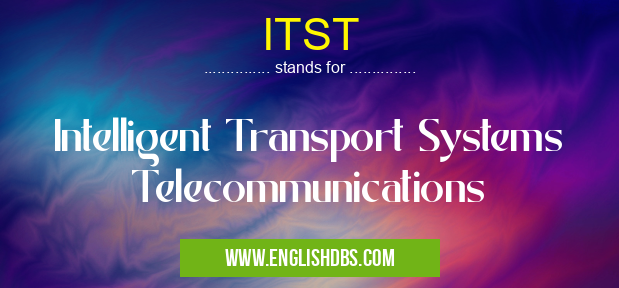What does ITST mean in TELECOM
Intelligent Transport Systems Telecommunications (ITST) refers to the integration of telecommunications technologies into transportation infrastructure to enhance traffic management, safety, and efficiency. It involves the application of information and communication technologies (ICT) to improve the performance and safety of transportation systems.

ITST meaning in Telecom in Computing
ITST mostly used in an acronym Telecom in Category Computing that means Intelligent Transport Systems Telecommunications
Shorthand: ITST,
Full Form: Intelligent Transport Systems Telecommunications
For more information of "Intelligent Transport Systems Telecommunications", see the section below.
ITST Meaning in COMPUTING
ITST encompasses a range of technologies that enable real-time communication and data exchange between vehicles, infrastructure, and traffic management systems. These technologies include:
- Vehicle-to-vehicle (V2V) communication: Allows vehicles to exchange information with each other, such as speed, position, and braking status.
- Vehicle-to-infrastructure (V2I) communication: Enables vehicles to interact with roadside infrastructure, such as traffic signals and electronic toll collection systems.
- Intelligent traffic management systems (ITMS): Provide real-time traffic information and control to optimize traffic flow and reduce congestion.
- Advanced traveler information systems (ATIS): Disseminate information to travelers about traffic conditions, alternative routes, and public transportation options.
- Location-based services (LBS): Utilize GPS and other technologies to provide personalized location-based information and services to drivers.
ITST Full Form
The full form of ITST is Intelligent Transport Systems Telecommunications. It signifies the convergence of telecommunications and transportation technologies to create smarter and more efficient transportation systems.
Benefits of ITST
ITST offers numerous benefits, including:
- Improved traffic efficiency: By optimizing traffic flow and reducing congestion.
- Enhanced safety: By providing drivers with real-time information and alerts about hazardous conditions or potential accidents.
- Reduced emissions: By promoting fuel-efficient driving and optimizing vehicle routing.
- Improved public transportation: By providing real-time information and seamless integration with other transportation modes.
- Economic benefits: By reducing travel times, fuel costs, and vehicle emissions.
Essential Questions and Answers on Intelligent Transport Systems Telecommunications in "COMPUTING»TELECOM"
What are Intelligent Transport Systems Telecommunications (ITST)?
ITST refers to the use of telecommunications technologies to improve the efficiency, safety, and sustainability of transportation systems. It integrates various communication technologies, such as cellular networks, Wi-Fi, Bluetooth, and satellite communications, to enable real-time data exchange and information sharing between vehicles, infrastructure, and users.
What are the benefits of using ITST?
ITST provides numerous benefits, including:
- Improved traffic management: Real-time traffic data helps optimize traffic flow, reduce congestion, and improve travel times.
- Enhanced safety: Vehicle-to-vehicle (V2V) and vehicle-to-infrastructure (V2I) communication enable collision avoidance systems, blind spot monitoring, and other safety features.
- Increased efficiency: ITST allows for automated vehicle tracking, fleet management, and optimized routing, leading to improved logistics and operational efficiency.
- Reduced environmental impact: By optimizing traffic flow and improving fuel efficiency, ITST contributes to reducing emissions and promoting sustainability.
How is ITST implemented?
ITST implementation involves various components, including:
- Communication networks: Cellular networks, Wi-Fi, and satellite communications provide the underlying infrastructure for data transmission.
- On-board units: Installed in vehicles, these devices gather data from sensors and communicate with other vehicles and infrastructure.
- Roadside units: Placed along roadways, these devices collect and transmit traffic data to central management systems.
- Central management systems: These systems process and analyze data to provide real-time traffic information and enable advanced traffic management functions.
Final Words: ITST is a transformative technology that is revolutionizing the transportation industry. By leveraging telecommunications technologies, ITST enhances traffic efficiency, safety, and sustainability. As these technologies continue to evolve, we can expect even greater benefits for transportation users and society as a whole.
